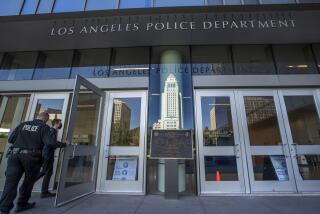Police Panel to Meet Today on Shooting Policy
Under pressure from Mayor James K. Hahn, the Los Angeles Police Commission scheduled a special session today to try to hammer out a new policy limiting police shooting.
The developments came as 13-year-old Devin Brown was buried Tuesday. Devin’s death -- he was shot by a police officer Feb. 6 while driving a stolen car -- triggered demands for tighter controls on police use of force.
Four members of the five-member commission had reached an impasse Tuesday over the wording of the new policy proposed by Chief William J. Bratton after Devin’s shooting. The panel then postponed action for two weeks -- until Hahn, who is running for reelection, publicly demanded that they try again sooner.
“I want to be very clear: I want this matter to be resolved immediately,” Hahn said during a news conference on the City Hall steps Tuesday evening, after the commission broke up without agreement.
“I am calling upon the Police Commission to adopt a policy that will go as far as possible to limit the circumstances in which a police officer can fire at a moving vehicle. It should be a rare and exceptional circumstance,” Hahn said.
Commission President David Cunningham III quickly complied, rescheduling the next meeting for today.
The Police Commission, which has the power to approve or disapprove policy binding on the Los Angeles Police Department, disagreed most deeply over when an automobile could be considered a deadly weapon.
Officers are now allowed to use deadly force when they reasonably believe they -- or a member of the public -- are in danger of death or serious injury. The policy states that “firing at or from moving vehicles is generally prohibited.” But the policy allows officers to justify use of force if a vehicle poses a deadly threat.
Bratton’s proposal would prohibit use of deadly force when the only danger is posed by a vehicle. He was supported by Cunningham and board member Rick Caruso.
But commissioners Rose Ochi and Alan Skobin said Bratton’s written policy was unclear. Skobin proposed a substitute that he said provides greater clarity but critics contend dilutes the strength of the ban on shooting.
Skobin suggested the policy should state that a vehicle itself should not constitute a threat that justifies the use of deadly force “unless the actions of the driver clearly demonstrate the driver’s intention to assault the officer or another person resulting in death or serious injury.”
In debate, Cunningham questioned how officers could know a driver’s intentions
Ricardo Garcia, of the American Civil Liberties Union of Southern California, said Skobin’s policy was a “dissolved version” of Bratton’s proposal.
Police Protective League President Bob Baker, who supports existing policy, praised Skobin, saying he “understands that moving vehicles are sometimes tragically used as lethal weapons, and that when criminals use cars to attack law enforcement or civilians, officers need to have the authority to use appropriate force to respond.”
Both proposals prohibited firing into vehicles unless a person inside is threatening others with deadly force
Assistant Chief Sharon Papa told commissioners that a moving vehicle would not be considered a weapon justifying deadly force. But she said that the policy could not anticipate every situation, and noted that “officers are expected to act with intelligence and sound judgment, attending to the spirit of the policy.”
Bratton said similar policies had been adopted nationwide and have been flexible enough to recognize exigent circumstances.
“No policy on earth can address every conceivable situation,” he said.
Hahn, who attended the Tuesday commission meeting, said later that Bratton, with decades of experience, is in the best position to come up with a policy that works.
It was the second time since Devin’s shooting that Hahn has stepped in and forcefully urged a more rapid response.
Last week, he publicly urged Bratton to move quickly after the chief said it would take 45 days to draft a comprehensive policy that he had called for last year.
More to Read
Sign up for Essential California
The most important California stories and recommendations in your inbox every morning.
You may occasionally receive promotional content from the Los Angeles Times.










